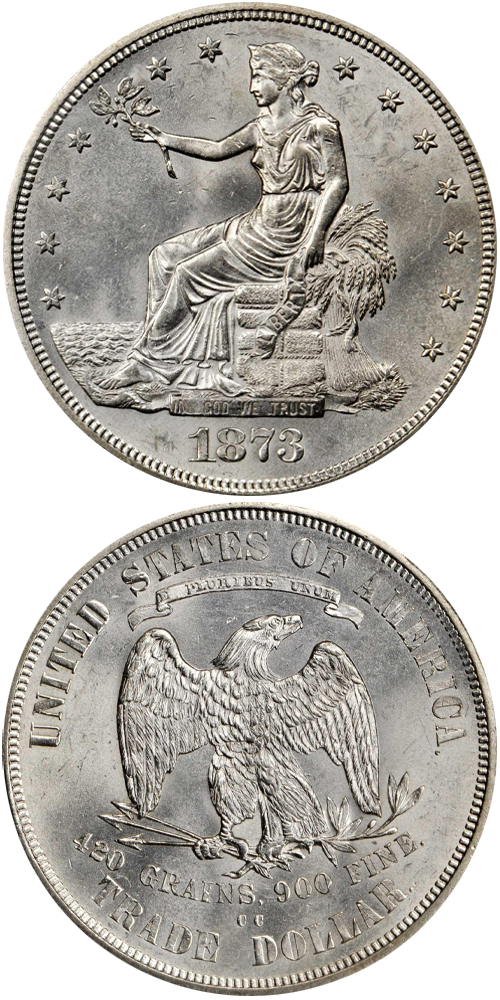1873-CC Trade Dollar
Rusty Goe: John Jay Knox, Deputy Comptroller of the Currency, proposed the need for a "commercial dollar" in his comprehensive coinage reformation plan submitted in various drafts beginning in 1870. He defined it as a trade-coin made of silver and approximating in weight the Spanish-Mexican piastres (or dollar), for the U.S. to export to oriental countries such as China and Japan. By the time the final draft of Knox's bill, on which he had collaborated with many consultants, reached Congress the trade-coin or commercial dollar appears as a "trade dollar."
Proponents of the trade dollar wanted to achieve several things. First, they wanted to shift the flow of silver exportation to the Orient (mainly China) from Mexico to the United States. Second, they wanted to establish San Francisco's primacy as a market for silver, a position held at the time by London. Third, they wanted to support silver's price in anticipation of ensuing supply increases. Many other mechanics played into the reasons behind the introduction of trade dollars, but the three intentions cited above provide a brief summary of the coin's perceived purposes.
Although rumors had circulated since late in 1872 that John Mackay's Consolidated Virginia Mine showed great potential, and newspapers in Virginia City and Gold Hill in March 1873 announced that the company had discovered a rich vein, no paying-ore had come forth by July of that year. Ever since Superintendent Rice had opened up the Carson Mint's assaying and refining departments to the public two years earlier, most of the bullion deposited there came from Gold Hill's Crown Point and Belcher mines, with sparse amounts channeling in from California locations such as Benton. If reports about the Consolidated Virginia's bountiful strike played out the Carson Mint would become a prime beneficiary.
Residents of Carson City and especially those employed at the mint, welcomed news about the Comstock's potential new bonanza, as well as news about the new trade dollars. After the Philadelphia Mint struck the first pieces of that innovative coin on July 11, 1873, a closely watched race ensued to see which branch out West would stamp the first example bearing a mintmark.
In the July 23, 1873 edition, the Appeal ran a feature story, using the theme, "THE FIRST TRADE DOLLAR ever coined west of Philadelphia." The reporter from the day before shared how "Superintendent [Frank D.] Hetrich had it all nicely swathed and cuddled in a bit of tissue paper," when he showed the first 1873-CC trade dollar to those in attendance.
If the figures published in the Appeal are accurate, the Carson Mint coiner, William Hy Doane, "ran through the press" 4,500 trade dollars on the first day. By the end of December he had added another 120,000 to that first batch of 4,500, to bring the first-year total to 124,500.
As far as the survival rate for 1873-CC trade dollars, we see that the percentage drops to levels of most of the other pre-1878 coins from the Carson City Mint.
Q. David Bowers: In 1873 124,500 trade dollars were minted at the Carson City Mint. Rusty Goe estimates that there are 500 to 750 known, of which 50 to 75 are Uncirculated. As curious as it seems now, in the 1870s the numismatic community nearly completely ignored trade dollars except for Philadelphia Mint Proofs. It was almost as if they did not exist! Interest was very slow in coming, and it was not until the second half of the 20th century that circulation strike trade dollars became eagerly sought. By that time nearly all high grade coins had disappeared.
The example to the left was sold by Stack's Bowers Galleries in the August 2018 Philadelphia ANA Auction, where it realized $31,200.






